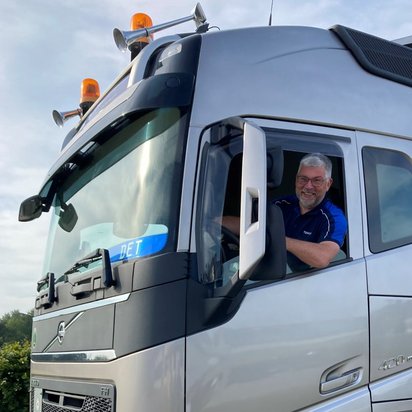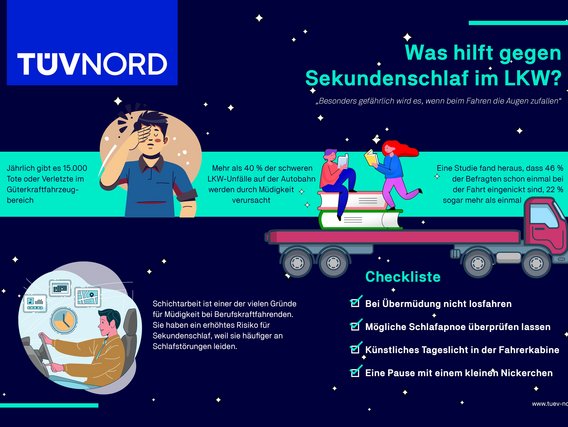What helps against microsleep in trucks?
Mobility: Fahrende von Lastkraftwagen sind besonders gefährdet, am Steuer einzuschlafen. Woran man den Sekundenschlaf erkennt und wie man ihm vorbeugen kann.

Mobility: Fahrende von Lastkraftwagen sind besonders gefährdet, am Steuer einzuschlafen. Woran man den Sekundenschlaf erkennt und wie man ihm vorbeugen kann.

A collision with a truck weighing several tons often has dramatic consequences. Every year, more than 15,000 accidents with fatalities or injuries are caused by goods vehicles. One of the causes of accidents is fatigue. It is not only dangerous for other road users: more than 40 percent of serious truck accidents on the highway, in which no one else is involved, are caused by fatigue at the wheel.
“It becomes particularly dangerous when your eyes close while driving,” warns Dennis Dal Mas from the Medical-Psychological Institute of TÜV NORD in Bielefeld. A survey conducted by the German Road Safety Council in 2016 found that microsleeps are not that rare. 46% of the 350 or so truck drivers surveyed - almost exclusively men - said they had dozed off while driving, and 22% had even done so more than once. Bus drivers are not immune to this either: according to the European Transport Workers Federation 2021, just under a quarter of them had fallen asleep while driving at least once in the previous year.

“Driving overtired in this way is a criminal offense,” says Dennis Dal Mas, a doctor of psychology. Anyone who falls asleep at the wheel and thus endangers the life and limb of others can expect a fine or up to five years in prison. However, many people get into their cars tired in the morning and still arrive safely at their destination. So how can you tell if fatigue is getting the better of you?
“The first signs are frequent yawning, itchy or burning eyes and heavy eyelids, often a leaden heaviness in the limbs or physical restlessness,” explains Dennis Dal Mas. Shortly before falling asleep, there are further acute warning signs, as a Japanese research group reported last year. Using camera recordings from inside trucks, the team was able to attribute 52 accidents to microsleep. Typical precursors occurred up to 60 seconds before the accidents: Drivers had increasing problems keeping in their lane.
In this first phase, they still tried to fight the urge to sleep, for example by rubbing their heads or eyes. In phase two, around 40 seconds before the collision, these attempts diminished. The last chance to avoid an accident. Because in the third phase, when the drivers barely moved or stopped moving altogether, there were only a few seconds left: Then they lost control of themselves and the vehicle.
Of course, it would be better not to set off in the first place if you are overtired. Even before getting into the car, there are measurable indications that the sleep pressure is simply too great: the eyes give it away. For example, shift workers blinked for longer before starting their journey if they showed signs of microsleep on the subsequent journey - which was the case for one in ten journeys.
Shift work is one of the many reasons for fatigue among professional drivers. They have an increased risk of microsleep because they suffer more frequently from sleep disorders, warns the German Society for Sleep Research and Sleep Medicine. Night-time breathing stops, known as “sleep apnoea”, make people particularly tired. Professional drivers with this sleep disorder have a significantly higher accident rate.
Experts are therefore calling for this occupational group to be regularly checked for sleep apnoea - using a measuring device that monitors breathing during sleep. Asking is not enough, as many of those affected do not even know that they suffer from it. Treatment can reduce apnoea and thus also daytime sleepiness. Cognitive behavioral therapy is usually recommended for other sleep disorders.
In addition, artificial daylight in the driver's cab can help with problems with the sleep-wake rhythm - even in broad daylight, as only a small amount of daylight gets through the windshield. According to the vehicle manufacturer Mercedes-Benz, the additional light at the wheel has an activating effect on truck drivers.
But what if tiredness becomes overwhelming despite everything? In the survey by the German Road Safety Council mentioned at the beginning, three out of four truck drivers said that they then take a break. Around one in two said they used the break to take a nap, and just under one in three reached for caffeinated drinks. Such measures can actually help for a while, unlike opening the window, for example: That only works for a short time or not at all.
However, due to time pressure and a lack of parking spaces for trucks, some drivers forgo the breaks they actually need, which is why the German Road Safety Council called for more checks on driving and rest times in commercial road traffic in 2022, as well as more rest areas on freeways. The Council also recommended that more so-called rumble strips be installed on critical stretches of road: Roadside markings that make a noise when driven over. They can alert drivers at the last moment when they leave the lane.
The EU has already provided for another warning system: in future, vehicle technology is to detect tiredness based on eye and steering movements. Such drowsiness warning systems will be mandatory for all new cars, trucks and buses from summer 2024. “The others should definitely retrofit them,” says Dennis Dal Mas from TÜV NORD. However, the psychologist warns that the technology does not absolve anyone of the responsibility to pay attention to possible warning signs and to pull out of traffic in good time.
Founded over 150 years ago, we stand for security and trust worldwide. As a knowledge company, we have our sights firmly set on the digital future. Whether engineers, IT security experts or specialists for the mobility of the future: in more than 100 countries, we ensure that our customers become even more successful in the networked world.